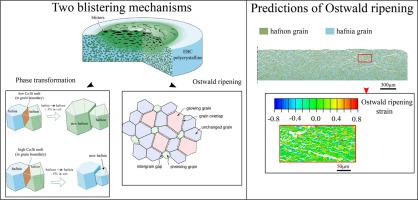暴露在熔融硅酸盐沉积物中的哈夫纳/哈夫农复合材料起泡
IF 8.3
1区 材料科学
Q1 MATERIALS SCIENCE, MULTIDISCIPLINARY
引用次数: 0
摘要
本文章由计算机程序翻译,如有差异,请以英文原文为准。

Blistering of hafnia/hafnon composites exposed to molten silicate deposits
Environmental barrier coatings (EBCs) are critical for protecting ceramic matrix composites in gas turbine engines. However, their effectiveness can be compromised by blistering when exposed to molten silicate deposits. This study investigates the mechanisms driving blistering in hafnia/hafnon EBCs through numerical modelling. Two potential mechanisms are explored: one driven by partial dissolution of the parent phases into the melt followed by crystallization into the other phase (hafnia to hafnon or vice-versa) and another driven by partial dissolution and reprecipitation into the same phase via Ostwald ripening. Models for both mechanisms make use of the observations that melt ingress and macroscopic blistering are decoupled in time, with melt ingress occurring relatively rapidly along grain triple junctions and blistering occurring later through a slower process of melt spreading, dissolution and crystallization or reprecipitation. A finite element model incorporating randomly shaped grains and cohesive grain boundaries is developed to simulate these two mechanisms. Phase transformation-driven cracking is found to produce minimal damage and negligible changes in pellet thickness, inconsistent with experimental observations. In contrast, the Ostwald ripening mechanism generates damage patterns and pellet thickness increases closely resembling experimental blistering observations, even though the ripening process produces only modest stresses. Combined effects of phase transformation and Ostwald ripening show no significant synergy. These findings suggest Ostwald ripening as the dominant mechanism responsible for blistering in hafnia/hafnon EBCs exposed to molten silicate deposits. The study provides valuable insights into EBC failure modes and offers a framework for investigations of similar phenomena in other coating systems.
求助全文
通过发布文献求助,成功后即可免费获取论文全文。
去求助
来源期刊

Acta Materialia
工程技术-材料科学:综合
CiteScore
16.10
自引率
8.50%
发文量
801
审稿时长
53 days
期刊介绍:
Acta Materialia serves as a platform for publishing full-length, original papers and commissioned overviews that contribute to a profound understanding of the correlation between the processing, structure, and properties of inorganic materials. The journal seeks papers with high impact potential or those that significantly propel the field forward. The scope includes the atomic and molecular arrangements, chemical and electronic structures, and microstructure of materials, focusing on their mechanical or functional behavior across all length scales, including nanostructures.
 求助内容:
求助内容: 应助结果提醒方式:
应助结果提醒方式:


